1.AVL树的概念
当向二叉搜索树中插入新结点后,如果能保证每个结点的左右子树高度之差的绝对值不超过1(需要对树中的结点进行调整),即可降低树的高度,从而减少平均搜索长度。
一棵AVL树或者是空树,或者是具有以下性质的二叉搜索树:
①它的左右子树都是AVL树
②左右子树高度之差(简称平衡因子)的绝对值不超过1(-1/0/1)如果一棵二叉搜索树是高度平衡的,它就是AVL树。
2.AVL树的插入和旋转
AVL树的插入:

3.AVL树的旋转
3.1旋转的底层:
以右旋转为例:

3.2 右旋转
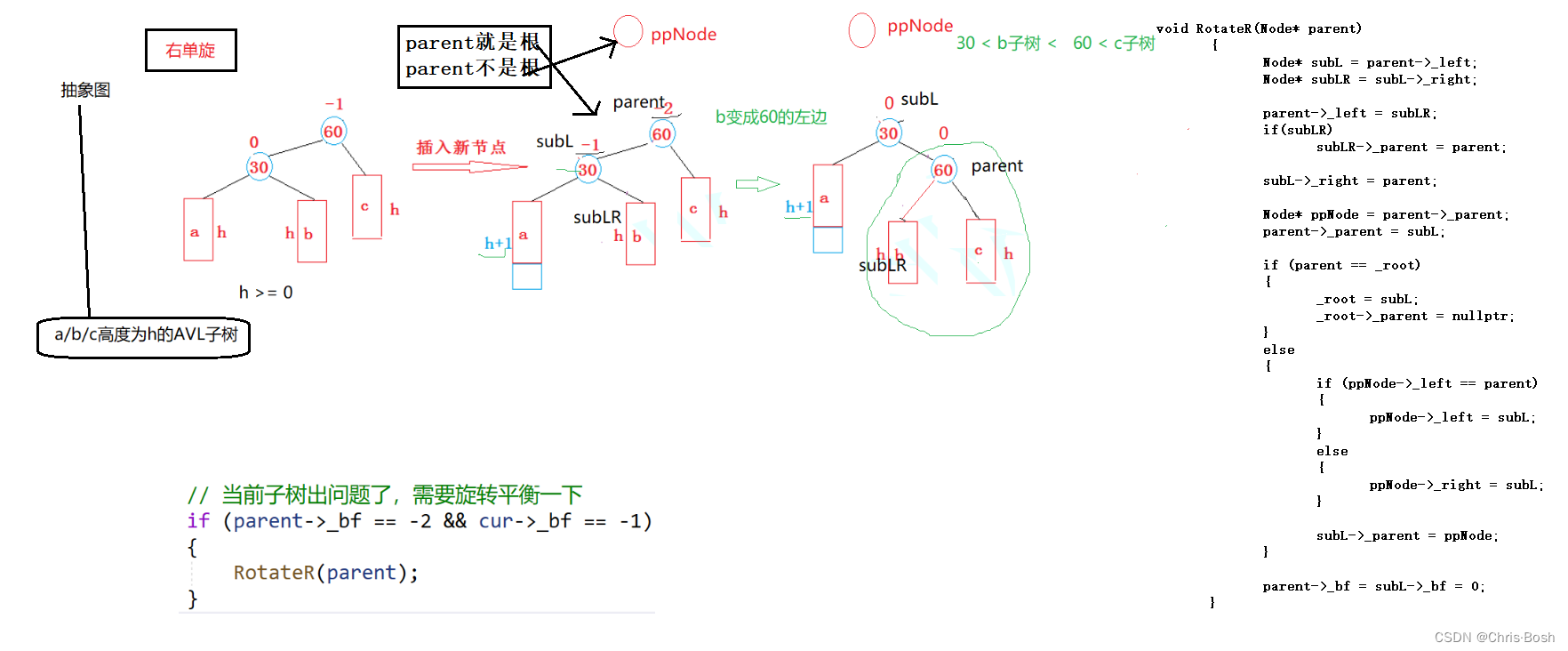
3.3 左旋转
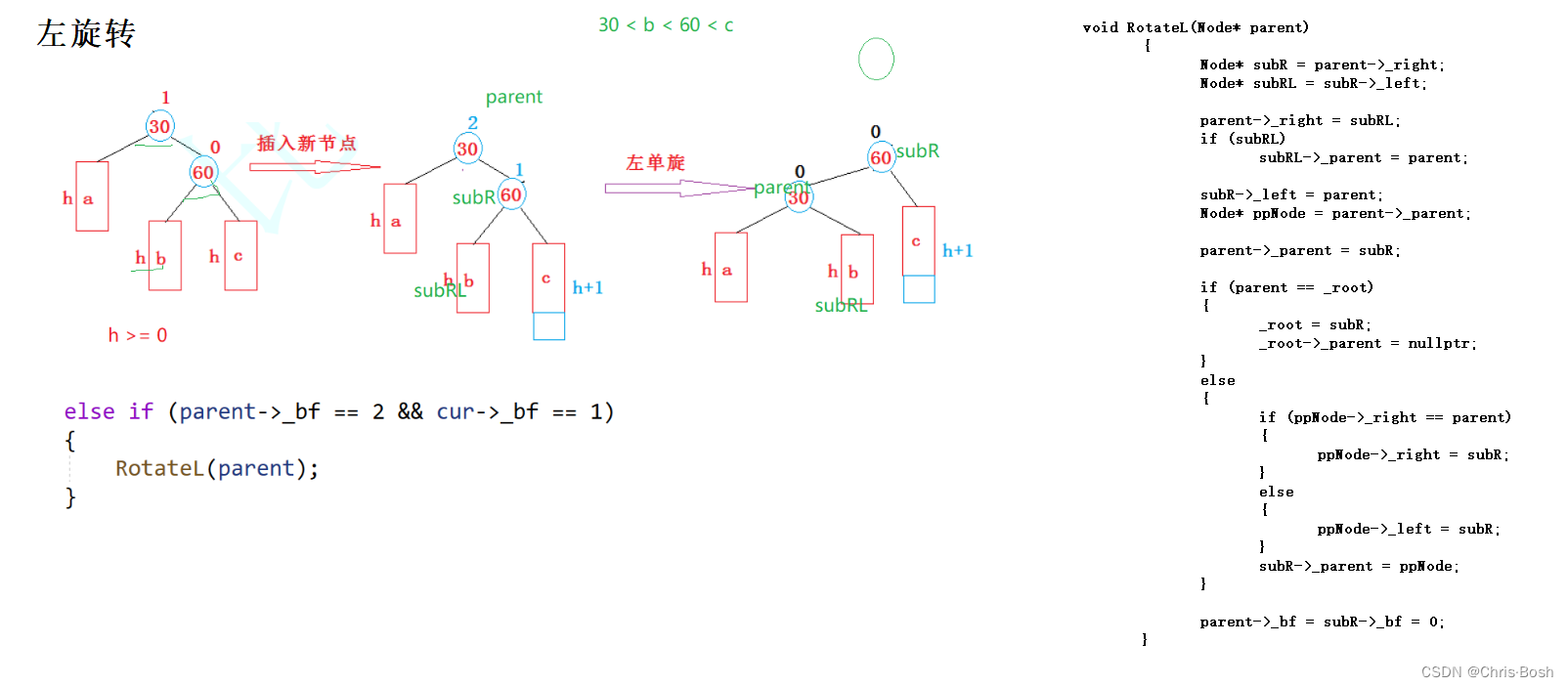
3.4 双旋
右左双旋:
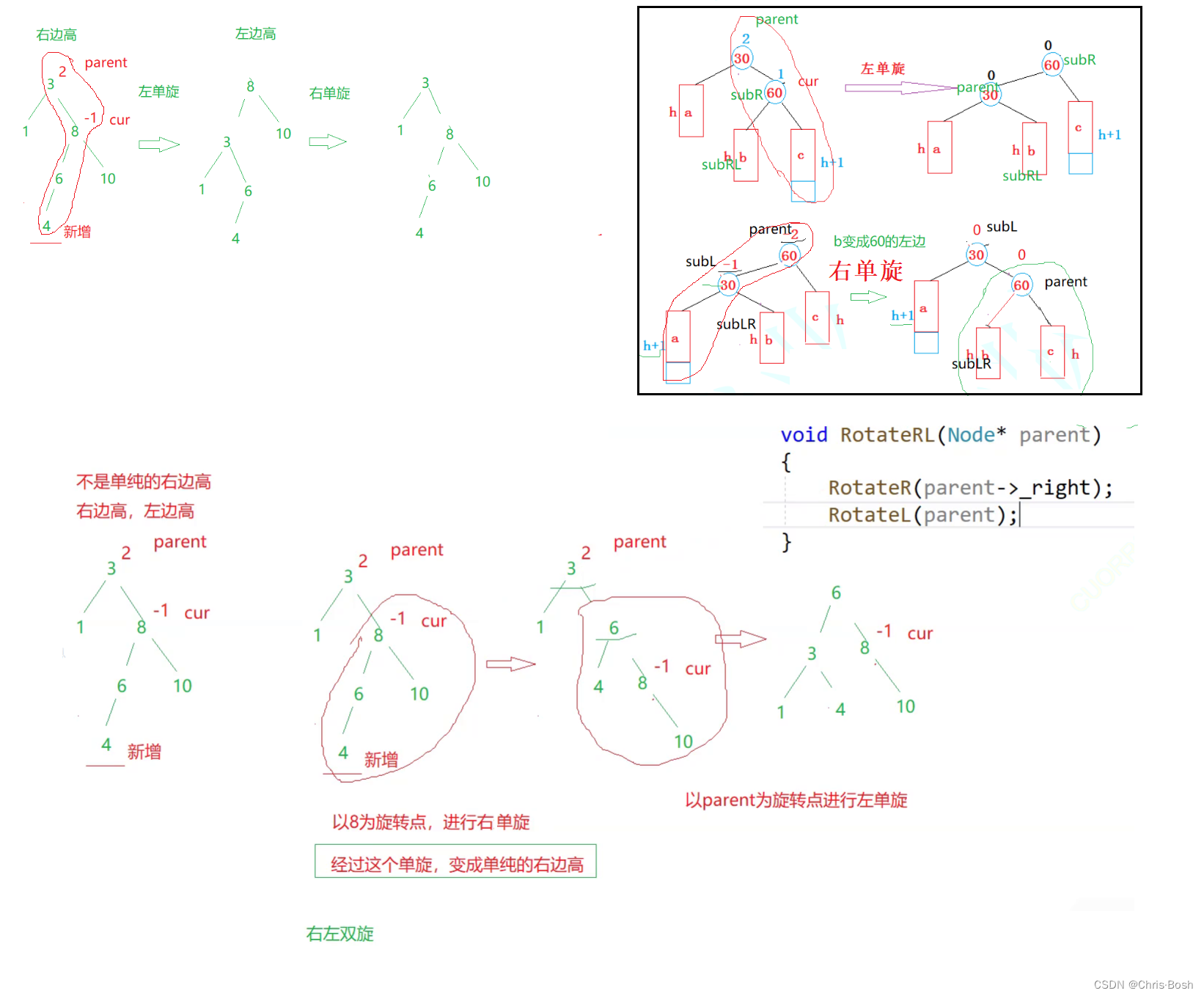
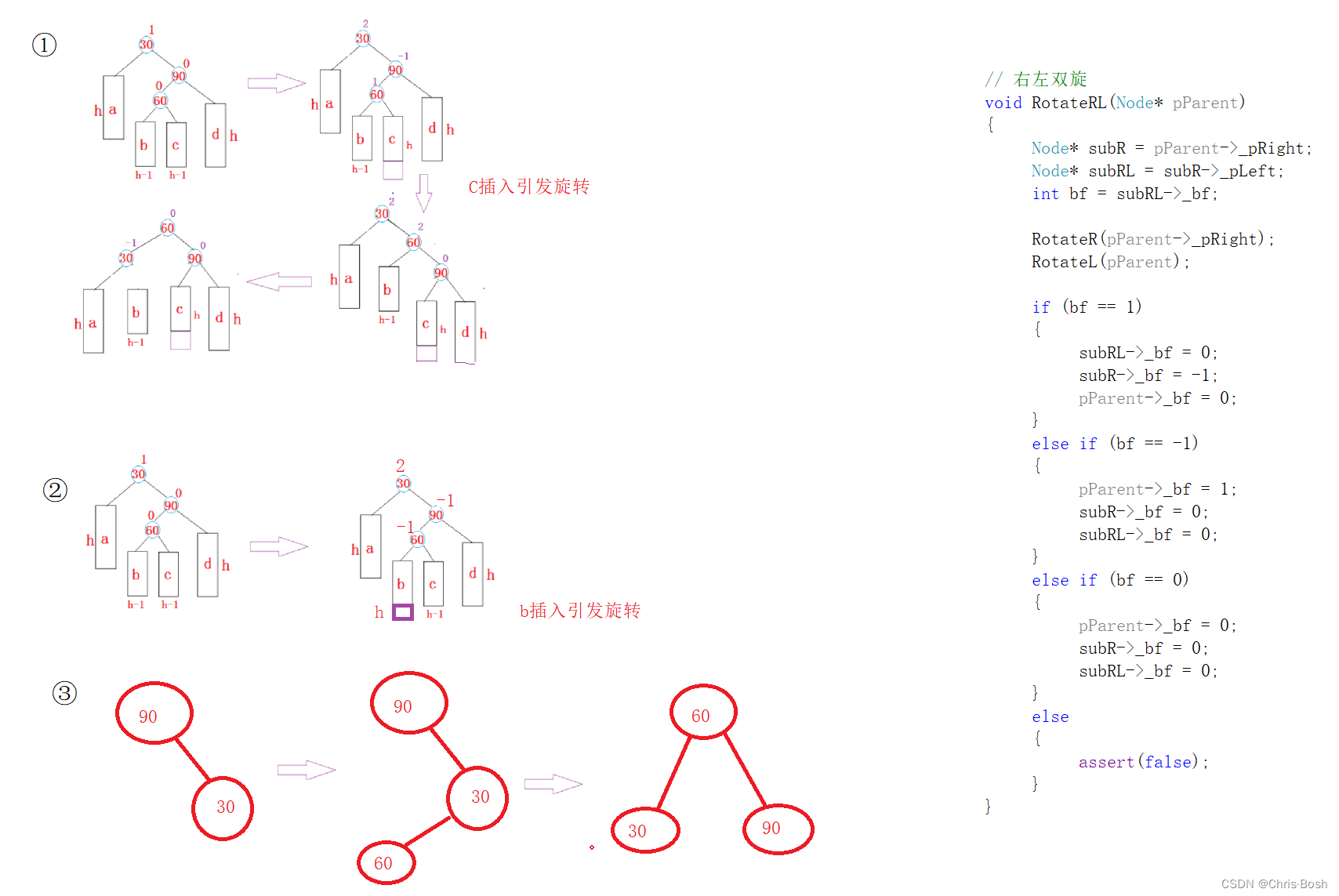
左右双旋:
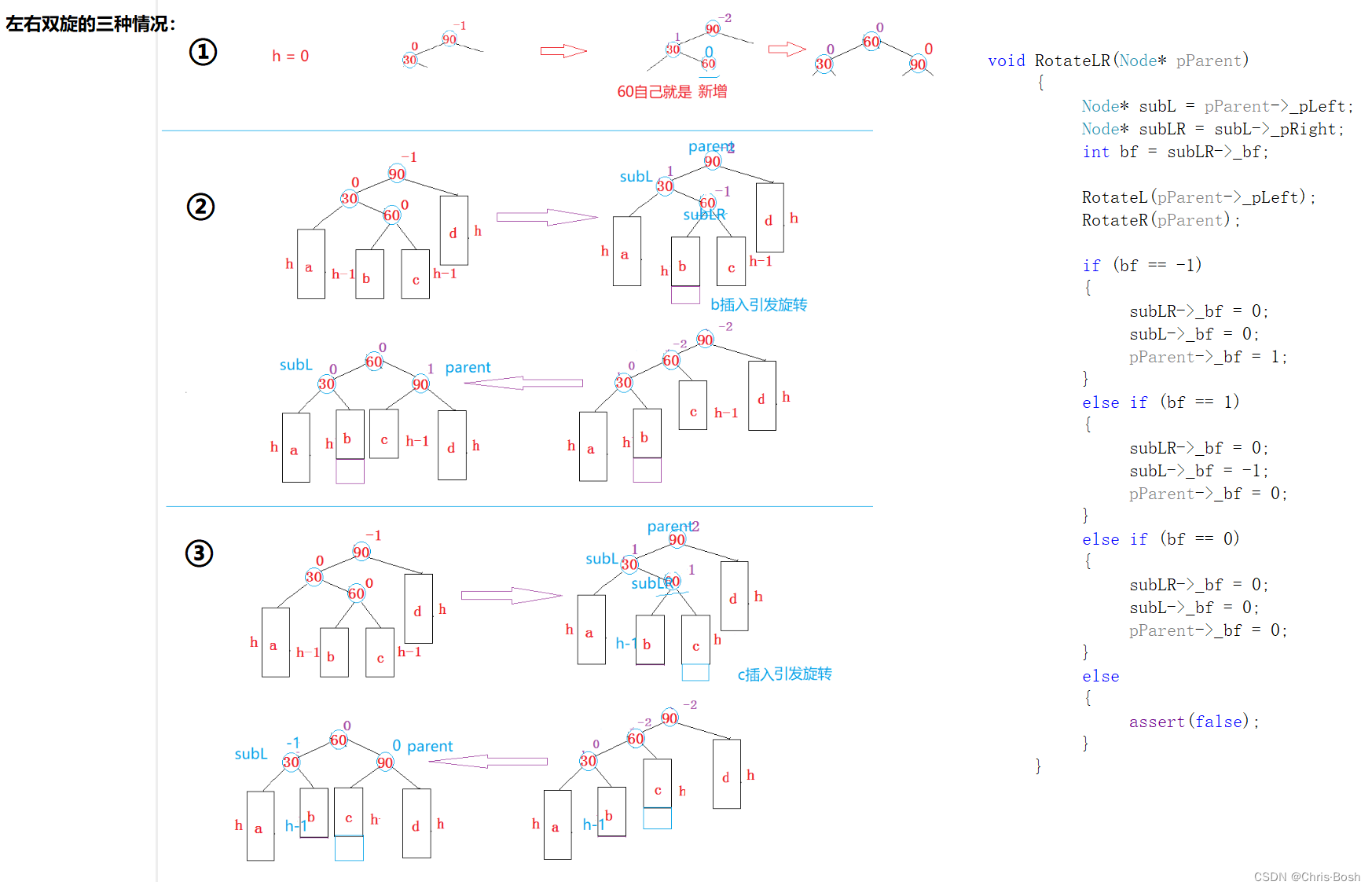
4.AVL树的底层
#pragma once
#include<assert.h>
#include<vector>
#include<iostream>
using namespace std;
template<class T>
struct AVLTreeNode
{
AVLTreeNode(const T& data = T())
: _pLeft(nullptr)
, _pRight(nullptr)
, _pParent(nullptr)
, _data(data)
, _bf(0)
{}
AVLTreeNode<T>* _pLeft;
AVLTreeNode<T>* _pRight;
AVLTreeNode<T>* _pParent;
T _data;
int _bf; // 节点的平衡因子
};
// AVL: 二叉搜索树 + 平衡因子的限制
template<class T>
class AVLTree
{
typedef AVLTreeNode<T> Node;
public:
AVLTree()
: _pRoot(nullptr)
{}
// 在AVL树中插入值为data的节点
bool Insert(const T& data)
{
if (_pRoot == nullptr)
{
_pRoot = new Node(data);
return true;
}
Node* parent = nullptr;
Node* cur = _pRoot;
while (cur != nullptr)
{
if (cur->_data < data)
{
parent = cur;
cur = cur->_pRight;
}
else if (cur->_data > data)
{
parent = cur;
cur = cur->_pLeft;
}
else
{
return false;
}
}
cur = new Node(data);
if (parent->_data < data)
{
parent->_pRight = cur;
}
else
{
parent->_pLeft = cur;
}
cur->_pParent = parent;
// 更新平衡因子
while (parent != nullptr)
{
if (cur == parent->_pLeft)
{
parent->_bf--;
}
else
{
parent->_bf++;
}
if (parent->_bf == 0)
{
break;
}
else if (parent->_bf == 1 || parent->_bf == -1)
{
cur = parent;
parent = parent->_pParent;
}
else if (parent->_bf == -2 || parent->_bf == 2)
{
// 当前子树出问题了,需要旋转平衡一下
if (parent->_bf == -2 && cur->_bf == -1)
{
RotateR(parent);
}
else if (parent->_bf == 2 && cur->_bf == 1)
{
RotateL(parent);
}
else if (parent->_bf == 2 && cur->_bf == -1)
{
RotateRL(parent);
}
else if (parent->_bf == -2 && cur->_bf == 1)
{
RotateLR(parent);
}
break;
}
else
{
// 理论而言不可能出现这个情况
assert(false);
}
}
return true;
}
// AVL树的验证
bool IsAVLTree()
{
return _IsAVLTree(_pRoot);
}
int Height()
{
return _Height(_pRoot);
}
int Size()
{
return _Size(_pRoot);
}
private:
// 根据AVL树的概念验证pRoot是否为有效的AVL树
bool _IsAVLTree(Node* pRoot)
{
if (pRoot == nullptr)
{
return true;
}
int leftHeight = _Height(pRoot->_pLeft);
int rightHeight = _Height(pRoot->_pRight);
// 不平衡
if (abs(leftHeight - rightHeight) >= 2)
{
std::cout << pRoot->_data << std::endl;
return false;
}
//检查一下平衡因子是否正确
if (rightHeight - leftHeight != pRoot->_bf)
{
cout << pRoot->_data << endl;
return false;
}
return _IsAVLTree(pRoot->_pLeft) && _IsAVLTree(pRoot->_pRight);
}
size_t _Height(Node* pRoot)
{
if (pRoot == nullptr)
return 0;
return max(_Height(pRoot->_pLeft), _Height(pRoot->_pRight)) + 1;
}
// 右单旋
void RotateR(Node* pParent)
{
Node* subL = pParent->_pLeft;
Node* subLR = subL->_pRight;
pParent->_pLeft = subLR;
if (subLR != nullptr)
{
subLR->_pParent = pParent;
}
subL->_pRight = pParent;
Node* ppNode = pParent->_pParent;
pParent->_pParent = subL;
if (pParent == _pRoot)
{
_pRoot = subL;
_pRoot->_pParent = nullptr;
}
else
{
if (ppNode->_pLeft == pParent)
{
ppNode->_pLeft = subL;
}
else
{
ppNode->_pRight = subL;
}
subL->_pParent = ppNode;
}
pParent->_bf = subL->_bf = 0;
}
// 左单旋
void RotateL(Node* pParent)
{
Node* subR = pParent->_pRight;
Node* subRL = subR->_pLeft;
pParent->_pRight = subRL;
if (subRL != nullptr)
{
subRL->_pParent = pParent;
}
subR->_pLeft = pParent;
Node* ppNode = pParent->_pParent;
pParent->_pParent = subR;
if (pParent == _pRoot)
{
_pRoot = subR;
_pRoot->_pParent = nullptr;
}
else
{
if (ppNode->_pRight == pParent)
{
ppNode->_pRight = subR;
}
else
{
ppNode->_pLeft = subR;
}
subR->_pParent = ppNode;
}
pParent->_bf = subR->_bf = 0;
}
// 右左双旋
void RotateRL(Node* pParent)
{
Node* subR = pParent->_pRight;
Node* subRL = subR->_pLeft;
int bf = subRL->_bf;
RotateR(pParent->_pRight);
RotateL(pParent);
if (bf == 1)
{
subRL->_bf = 0;
subR->_bf = -1;
pParent->_bf = 0;
}
else if (bf == -1)
{
pParent->_bf = 1;
subR->_bf = 0;
subRL->_bf = 0;
}
else if (bf == 0)
{
pParent->_bf = 0;
subR->_bf = 0;
subRL->_bf = 0;
}
else
{
assert(false);
}
}
// 左右双旋
void RotateLR(Node* pParent)
{
Node* subL = pParent->_pLeft;
Node* subLR = subL->_pRight;
int bf = subLR->_bf;
RotateL(pParent->_pLeft);
RotateR(pParent);
if (bf == -1)
{
subLR->_bf = 0;
subL->_bf = 0;
pParent->_bf = 1;
}
else if (bf == 1)
{
subLR->_bf = 0;
subL->_bf = -1;
pParent->_bf = 0;
}
else if (bf == 0)
{
subLR->_bf = 0;
subL->_bf = 0;
pParent->_bf = 0;
}
else
{
assert(false);
}
}
private:
Node* _pRoot;
};
void TestAVLTree1()
{
//int a[] = { 8, 3, 1, 10, 6, 4, 7, 14, 13 };
int a[] = { 4, 2, 6, 1, 3, 5, 15, 7, 16, 14 };
AVLTree<int> t1;
for (auto e : a)
{
// 1、先看是插入谁导致出现的问题
// 2、打条件断点,画出插入前的树
// 3、单步跟踪,对比图一一分析细节原因
t1.Insert({ e});
cout << "Insert:" << e << "->" << t1.IsAVLTree() << endl;
}
cout << t1.IsAVLTree() << endl;
}
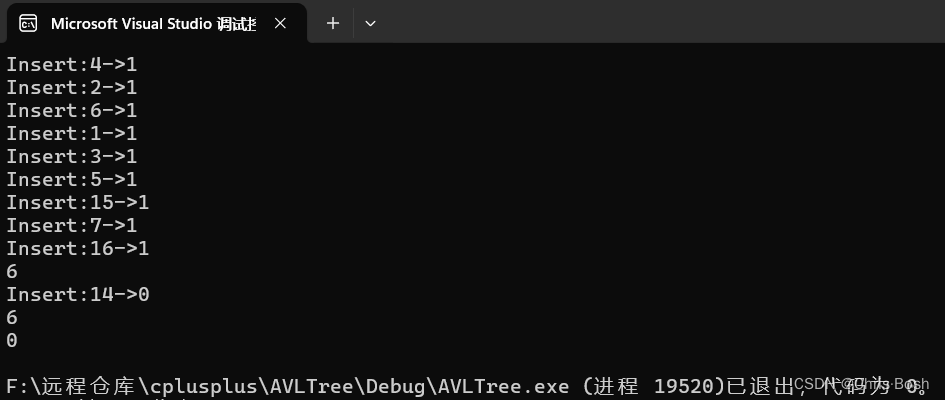
























 1192
1192

 被折叠的 条评论
为什么被折叠?
被折叠的 条评论
为什么被折叠?










